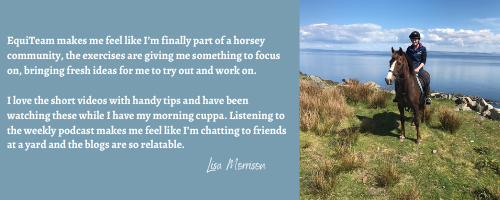Ann McKillop, Healthcare Course Coordinator from The First Aid Training Cooperative shares what should and shouldn’t be in your first aid kit.
First Aid Kits can have varied contents depending on the knowledge and experience of those putting it together, the workplace settings and any specific legislation related that setting. In short, they need to be fit for purpose and compliant.
It’s a legal requirement to have a first aid kit. The Health and Safety Executive website covers the legal compliance side first aid kits.
What should be in an equestrian first aid kit?
- Sterile plasters for small cuts and grazes – waterproof or showerproof;
- Medi-wipes to clean a wound;
- Two eye bandages;
- Four triangular bandages. These are large triangular shaped pieces of material that can be used as a bandage or sling or, if sterile, as a dressing for larger wounds and burns;
- Two large wound dressings that are used to apply pressure to help stop bleeding – they are quick and easy to apply;
- Disposable gloves in different sizes. This reduces the risk of infection between you and the casualty. Use non-latex gloves to avoid allergic reactions. Have different colours for different sizes as this helps you find the right glove for you;
- Face shields or pocket masks – designed to prevent infection when you give rescue breaths to a non-breathing casualty;
- Basic first aid manual or instruction booklet;
- ‘Tough cut’ or medical style scissors – strong enough to cut through clothing worn by equestrians.
Additional useful contents:
- Instant ice pack – Ensure it is wrapped in a cloth when used as it can cause ice burns onto naked skin;
- Foil blankets to keep the casualty warm, crucially important in helping to prevent them going into shock;
- Tick removers;
- A contents list – it should be someone’s responsibility to ensure that first aid kits are kept fully stocked and up to date.
What should NOT be in an equestrian first aid kit?
- No Painkillers. Diagnosing is beyond the scope of a first aid course. Often these drugs can interfere with prescribed medicines or cause allergic reactions;
- No creams, lotions or potions – No antiseptic cream, Iodine spray, tea tree oil or burns creams or gels – unless you have done a Risk Assessment and decided to include additional creams or potions – plus completed some training or guidance on their use;
- No Alcohol – Does it belong in a first aid kit? In addition to impairing judgement, alcohol can also lead to some casualties becoming hypothermic;
- No ‘Sharps’ – No scalpels or hypodermic needles! These items are beyond the approved skills of a first aider.
Care of First Aid Kits in Equestrian Centres – our top tips!
It should be easy to find – First Aid kits are usually in a green box or bag that’s marked with a white cross and should be easy to find and in an obvious place. The type of container will vary depending on location. Rider leaders often carry a bum bag style first aid kit.
Easy to find things – Organise your kit contents into sensible sections. The first thing you need to access is gloves. Get everything you need out of the kit BEFORE you treat a bleeding casualty to avoid contaminating the contents of the kit with bloody or dirty gloves.
Medication – The only medications you may have in a first aid kit is Aspirin (for use in heart attacks).
Cleanliness and storage – All kits should be in a clean, waterproof container. It should be stored away from heat and humidity, within easy reach for adults but out of the reach of children. Avoid locking or complicated closures.
Up to date? – Kits should also be checked regularly and restocked if any items are damaged or are out of date.

Get confident – get trained!
Having a kit on site is great, but you also need to know how to use the equipment in your first aid kit. A first-aid course is recommended, with a refresher every three years in order to keep your knowledge current.
Our courses are structured to give you confidence in dealing with an incident as well as the competence to do good quality first aid. Find out more about our courses on our specific equestrian first aid webpage.
Our digital First Aid Manual and Equestrian Specific Accident book:
Everyone on our courses receives a FREE digital first aid manual. We have a range of manuals relevant to the courses we teach – Outdoor, First Aid at Work, Paediatric, Equestrian and Sports. They are a great resource that you can download onto your phone or other device and have all that first aid knowledge at your fingertips. You can view them and buy them for less than £5 here.
We have also produced an equestrian specific Accident Book for horse riding establishments. You can view and buy it here.
You can find out more about The First Aid Training Cooperative here.






